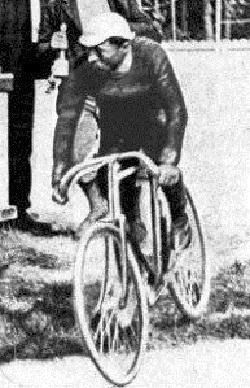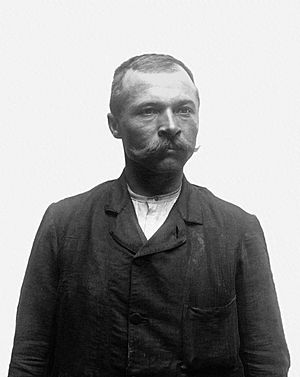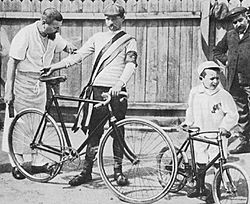Maurice Garin facts for kids

Garin in 1897
|
|||
| Personal information | |||
|---|---|---|---|
| Full name | Maurice-François Garin | ||
| Nickname | Le petit ramoneur (The Little Chimney-sweep) |
||
| Born | 3 March 1871 Arvier, Aosta Valley, Italy |
||
| Died | 19 February 1957 (aged 85) Lens, France |
||
| Height | 1.62 m (5 ft 4 in) | ||
| Weight | 60 kg (132 lb) | ||
| Team information | |||
| Discipline | Road and track | ||
| Role | Rider | ||
| Rider type | Distance rider | ||
| Major wins | |||
|
|||
Maurice-François Garin (pronounced: [mɔʁis fʁɑ̃swa ɡaʁɛ̃, moʁ-]; 3 March 1871 – 19 February 1957) was an Italian then French road bicycle racer best known for winning the inaugural Tour de France in 1903, and for being stripped of his title in the second Tour in 1904 along with eight others, for cheating. He was of Italian origin but adopted French nationality on 21 December 1901.
Contents
Family life

Garin was born the son of Maurice-Clément Garin and Maria Teresa Ozello in Arvier, in the French-speaking Aosta Valley in north-west Italy, close to the French border. The name Garin was the most common in the native village of Maurice, called "Chez-les-Garin", belonging to five of the seven families. They had four daughters and five sons, of whom Maurice was the first son.
In 1885 the family left Arvier to work on the other side of the Alps, almost to the Belgian border.
Garin worked as a chimney sweep. He later moved to France. By the age of 15, he was living in Reims as a chimney sweep. He moved to Charleroi in Belgium but by 1889 he was back in France, at Maubeuge.
Garin's younger brother, Joseph-Isidore, died in 1889. The father died shortly afterwards in Arvier. Garin's brothers François and César stayed in northern France and, with Maurice, opened a cycle shop in the lower end of the boulevard de Paris in Roubaix in 1895. Brothers César and Ambroise also competed as professional cyclists.
Garin moved to Lens, Pas-de-Calais in 1902 and lived there the rest of his life. He bought his first bicycle for 405 francs, twice what a forge worker would earn in a week of 12-hour days, in 1889. Racing did not interest him but he did ride round the town fast enough to be called a madman — le fou.
Amateur racing
He began racing in northern France in the same year when the secretary of the cycling club at Maubeuge persuaded him to enter a regional race, Maubeuge-Hirson-Maubeuge, over 200 km. Garin finished fifth despite suffering from the sun and decided to ride more.
His first win was in 1893, in Namur-Dinant-Givet in Belgium. He had sold his first bike and bought a lighter one — still 16 kg but with pneumatic tyres — for 850 old French francs (approx €3,000 at 2008 values). The race was over 102 km. He was leading by Dinant when he punctured. Spotting a soigneur waiting with a spare bike for a rival, Garin rested his own against the wall of a bridge, grabbed the soigneur's spare bike and rode off. At the finish, winning with ten minutes over the field, he gave back the bike and recovered his own the next day where he had left it.
Professional racing
Garin became a professional by chance. He planned to ride a race at Avesnes-sur-Helpes, 25 km from where he lived. He arrived to find it was only for professionals. Not allowed to compete, he waited until the riders had left, raced after them and passed them all. He fell off twice but finished ahead of the racers. The crowd was enthusiastic but the organisers less so. They refused to pay him the 150 francs (approx €525 at 2008 values) due to the real winner, so spectators raised 300 francs (approx €1,050 at 2008 values) among themselves. Garin became a professional.
His first true professional win was in a 24-hour race in Paris in 1893. It was held on the Champ de Mars, site of the Eiffel Tower. The riders competed, as was the custom, behind a succession of pacers. The event took place in February and the cold drove out riders one after the other. Garin rode 701 km in 24 hours, beating the only other rider to finish by 49 km. While other riders would consume much strong red wine, Garin chose a more apt diet, and said he had survived on:
- 19 litres of hot chocolate
- seven litres of tea
- eight cooked eggs
- a mix of coffee and champagne
- 45 cutlets
- five litres of tapioca
- two kilos of rice
- and oysters.
In 1894 he won a 24-hour race in Liège, Belgium, and the following year set an hour record for cycling behind pacers.
The first Paris–Roubaix was in 1896; Garin came third, 15 minutes behind Josef Fischer. He would have come second had he not been knocked over by a crash between two tandems, one of them ridden by his pacers. Garin "finished exhausted and Dr Butrille was obliged to attend the man who had been run over by two machines," said the race historian, Pascal Sergent.
In 1897 he won Paris–Roubaix, beating the Dutchman Mathieu Cordang in the last two kilometres of the velodrome at Roubaix.
In 1898 he won Paris–Roubaix again, this time by 20 minutes, and in 1901 he won the second edition of Paris–Brest–Paris, finishing almost two hours ahead of Gaston Rivierre after covering 1,208 km in 52h 11m 1s. He started by chasing another Frenchman, Lucien Lesna, who rode the first 600 km at 28kmh and had two hours' lead at Brest. At Rennes he stopped for a bath to recover from the tiredness, filth and heat, then found he could not get racing again into the headwind. Garin passed him at Mayenne and Lesna gave up shortly afterwards with 200 km to go. Garin finished 19h 11m better than Charles Terront ten years earlier.
Until 2004, it was said that Garin had taken French nationality when he was 21, in 1892 but in 2004, the reporter Franco Cuaz found the naturalizing act and Garin took French nationality 21 December 1901.
In 1902 Garin won Bordeaux–Paris, a race of 500 km from south-west France.
Tour de France
1903 Tour de France
The Tour de France began to promote a new daily sports newspaper, L'Auto ahead of the largest paper in France, Le Vélo, which sold 80,000 copies a day. Some of Le Vélo's advertisers had disagreed with the paper's support for Alfred Dreyfus, a soldier found guilty on trumped up charges of selling secrets to the Germans but eventually acquitted after being sent to Devil's Island. The Tour was to promote their new rival paper, L'Auto.
The editor, Henri Desgrange, planned a five-week race from 31 May to 5 July. This proved too daunting and only 15 entered. Desgrange cut the length to 19 days and offered a daily allowance.
The race began at the Au Reveil Matin café at a crossroads in Montgeron, south of Paris, and ended in Ville-d'Avray, another suburb, having circuited France in six days of racing over 2,428 km. One stage, between Nantes and Paris, was 471 km. Sixty riders started at an entry fee of 10 francs – €87.50 today with inflation – and 21 finished. Garin won 3,000 francs (approx €10,500 at 2008 values) for finishing first in 94h 33m 14s, or 6,125 francs (approx €21,500 at 2008 values) in all with his other prizes. Lucien Pothier was second and Fernand Augereau third.
1904 Tour de France
Garin also won the 1904 Tour de France, by a small margin over Lucien Pothier, but was subsequently stripped of the title which was awarded to Henri Cornet. The race aroused a passion among spectators, who felled trees to hold back rivals and beat up others at night outside St-Étienne. Garin was one of the mob's victims.
Garin said: "I'll win the Tour de France provided I'm not murdered before we get to Paris."
Misbehaviour was rife too between riders and nine were thrown out during the race for, among other things, riding in or being pulled by cars. There were claims, too, that the organisers had allowed Garin to break rules — at one stage being given food where it was not permitted by its chief official — because his sponsor, La Française, had a financial stake in the race.
The French cycling union, the Union Vélocipédique Française, heard from dozens of competitors and witnesses and in December disqualified all the stage winners and the first four finishers: Garin, Pothier, César Garin, and Hippolyte Aucouturier. The UVF did not say precisely what had happened and the details were lost when Tour archives were transported south in 1940 to avoid the German invasion and never seen again. Stories spread of riders spreading tacks on the road to delay rivals with punctures, of riders being poisoned by each other or by rival fans. Lucien Petit-Breton said he complained to an official that he had seen a rival hanging on to a motorcycle, only to have the cheating rider pull out a revolver.
Tales were also said to include 'Garin taking a train', a claim confirmed by a cemetery attendant looking after his grave who, as a boy, heard Garin tell his stories as an old man. In December 1904 Garin was stripped of his title and banned for two years.
Retirement
Garin retired from cycling and ran his garage in Lens until his death. The garage is still there, although wholly changed from Garin's era.
Garin kept his interest in cycling. He returned just once to his birthplace, in 1949, to see the Tour pass through. He began a professional team under his name after the second world war. The Dutchman Piet van Est won Bordeaux–Paris in 1950 and 1952 in the team's red and white jersey. On the Tour's 50th anniversary in 1953, Garin was among several old stars waiting at the finish as part of a celebration.
Death and commemoration
In 1933 the Stade Vélodrome Maurice Garin was built in Lens, and named in his honour.
In 1938 Garin was awarded the gold medal of Physical Education by the Minister of Sport for France, Leo Lagrange.
Garin is remembered as a short, determined man, even authoritarian. As an old man he became confused.
In 2003 a street was named after him in Maubeuge on the 100th anniversary of his 1903 win in the Tour de France.
In 2004 Les Amis de Paris–Roubaix placed a cobblestone on his grave, a traditional trophy for winners of the Paris–Roubaix race.
In Arvier, the village in Italy where he was born, there is a monument in his honour. His biographer, Franco Cuaz, said: "Every year, the municipality sends me French people who want to see the house where he was born. It's like a pilgrimage."
Career achievements
Source: Maurice Garin at Cycling ArchivesLua error in Module:WikidataCheck at line 22: attempt to index field 'wikibase' (a nil value).
Major results
- 1893
- Dinant-Namur-Dinant
- Paris 80km (vélodrome)
- 1894
- Liège 24hr (vélodrome)
- Paris-Saint-Malo
- 1895
- 24hr Arts libéraux de Paris (vélodrome)
- Guingamp-Morlaix-Guingamp
- World record 500km behind human pacer on the road 15h 2m 32s
- 1896
- Paris-Le Mans
- Paris-Mons
- Liège-Thuin
- 3rd Paris–Roubaix
- 1897
- Paris–Roubaix
- Paris-Royan
- Paris-Cabourg
- Tourcoing-Béthune-Tourcoing
- 1898
- Paris–Roubaix
- Tourcoing-Béthune-Tourcoing
- Valenciennes-Nouvion-Valenciennes
- Douai-Doullens-Douai
- 50km Ostend (vélodrome)
- 2nd Bordeaux–Paris
- 1899
- 3rd Bordeaux–Paris
- 3rd Bol d'Or (vélodrome)
- 1900
- 2nd Bordeaux–Paris
- 2nd d Bol d'Or
- 3rd Paris–Roubaix
- 1901
- Paris–Brest–Paris
- 1902
- Bordeaux–Paris
- 1903
- Tour de France
Grand Tour general classification results timeline
| Grand Tour | 1903 | 1904 |
|---|---|---|
| Tour de France | 1 | DSQ |
| Giro d'Italia | N/A | N/A |
| Vuelta a España | N/A | N/A |
| 1 | Winner |
| 2–3 | Top three-finish |
| 4–10 | Top ten-finish |
| 11– | Other finish |
| DNE | Did Not Enter |
| DNF-x | Did Not Finish (retired on stage x) |
| DNS-x | Did Not Start (no started on stage x) |
| HD | Finished outside time limit (occurred on stage x) |
| DSQ | Disqualified |
| N/A | Race/classification not held |
| NR | Not Ranked in this classification |
See also
 In Spanish: Maurice Garin para niños
In Spanish: Maurice Garin para niños




